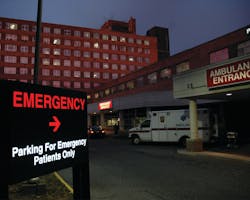The results of a recent survey commissioned by the International Association of Healthcare Security and Safety Foundation (IHSSF) found that there was slight increase in violent crime at hospitals in the U.S. and Canada between 2012 and 2013.
According to Karim H. Vellani, CPP, CSC, lead author of the “2014 Healthcare Crime Survey” and president of Threat Analysis Group, LLC, there were 1,437 incidents of violent crime - murder, rape, robbery and aggravated assaults – reported during 2012 compared to 1,669 reported in 2013, an increase of 16 percent. Additionally, Vellani said that there was also a nearly six percent increase in simple assaults in 2013 (5,784) compared to 2012 (5,464).
These statistics are based off of responses from 206 of 386 U.S. and Canadian hospitals that took part in the overall survey, which also collected data on incidents of disorderly conduct, burglary, theft, motor vehicle theft and vandalism. Of the 386 hospitals that took part in the survey, 242 provided usable responses. These 242 hospitals account for more than 209 million square feet of clinics, research space and medical office buildings, as well over 56,000 hospital beds.
IHSSF President Steve Nibbelink attributed this increase in violent crime to two things; the “health acuity” of people coming into hospitals being more severe, which is driving more destructive behavior from patients and their family members, as well as the fact that hospitals are doing a better job of educating their staff to report abuse and violence. “It’s a combination of better awareness of what a crime or an assault might be, as well as more crime coming into the facility,” said Nibbelink.
To better mitigate against violent crimes, Vellani said that hospitals need to be aware that these incidents are occurring, as he indicated that some of them still don’t have a firm grasp on what’s going within their own facilities.
“If you think about the hospitals that provided data to us (for the survey), these are the ones that had access to the data and some of the more rural hospitals may not do a good job of collecting this kind of data,” Vellani explained. “I think the most telling issue is looking at the difference between the number of hospitals (206) that provided us with aggregate crime data for the hospital – the number of assaults, aggravated assaults, thefts, those kinds of things – compared to the number of hospitals (164) that were able to provide us with the detailed crime information about workplace violence incidents. You can see even among the hospitals that responded, a majority were able to provide specific details, but not all of the hospitals were able to provide significant details about the crimes that occurred.”
In short, Vellani believes that hospitals need better metrics and assessment tools to identify solutions that are going to solve their particular issues. “Every hospital faces these things in a different way,” he added.
One of the things that stood out the most to Vellani from the results of the survey was the striking difference between the number of Workplace Violence Type 2 assaults (violence directed at employees by clients, patients, etc. for whom an organization provides services to), versus Type 1 (violent acts by criminals with no connection to the workplace) incidents. In fact, Type 2 assaults accounted for 75 percent of all aggravated assaults, and 93 percent of all assaults in 164 of the hospitals surveyed over the last two years.
“Security departments of hospitals spend a lot of time focusing on Type 1 Workplace Violence incidents and while those are a significant portion of the violent crimes and assaults that occur on a hospital property, it really is those Type 2 assaults that are the most concerning. They occur with the most frequency in the U.S. and Canada and they are the ones that impact the employees more directly,” said Vellani. “Focusing on efforts that prevent or mitigate Workplace Violence Type 2 incidents should be the focal point.
Although lawmakers in some states, such as California which recently saw two nurses stabbed in separate incidents, have proposed legislation as a means of helping to stem the tide of violence in hospitals, Vellani thinks that these types of measures are unnecessary.
“I think that each hospital is certainly capable of doing this and following basic guidelines like OSHA 3148 or whatever guidance is provided by the Joint Commission. But if you look at OSHA 3148, it is far more detailed on preventing workplace violence than the California law is or the Connecticut law is,” said Vellani. “I think the answer is they need to be doing it on their own. I don’t think legislation is all that helpful other than making them do it, but it is not very prescriptive.”



